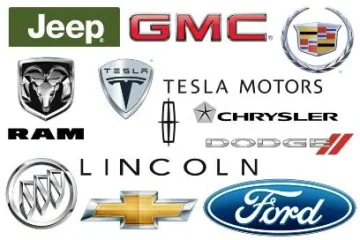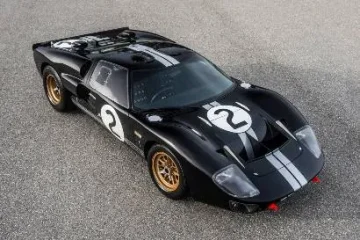Is The Ford Thunderbird The Most Overlooked American Icon?

Spanning five decades, the Ford Thunderbird represents a forgotten frontier of American automotive evolution. From its roots as a Euro-inspired roadster to its apex as a NASCAR-dominating machine, the Thunderbird not only pioneered the personal luxury car segment—it embodied shifting American ideals. This retrospective dives into all 11 generations and makes a strong case for why the Thunderbird deserves renewed attention.
Key Takeaway:
The Ford Thunderbird wasn’t just a car—it was an evolving expression of American ambition, influencing design, motorsports, and luxury for over 50 years.
Contents
1. 1955 Thunderbird vs. Corvette: A Luxury Rivalry Begins
When Chevrolet launched the Corvette in 1953, Ford responded with the 1955 Thunderbird—but with a different strategy. Instead of competing on raw speed, the Thunderbird offered refinement: a 292-cubic-inch V8, removable hardtop, and sophisticated styling. It sold 16,155 units in its first year versus the Corvette’s 700 (Ford Archives).
Why It Matters: This marked the birth of the “personal luxury car” genre—something entirely new in postwar America.

2. The Birth Of A Segment: Four-Seater Elegance (1958–1960)
By 1958, the Thunderbird transitioned to a four-seat layout, responding to internal Ford market research indicating a desire for “luxury without extravagance.” It was stylish, attainable, and sold over 200,000 units during its three-year run (Automotive News Archives).
Expert Insight: “The 1958–60 Thunderbird was America’s first true personal luxury car,” says John Clor, Ford Performance historian (Ford Performance).
3. Indy 500 Pace Car Glory: The 1961 Thunderbird
Chosen as the official pace car for the 50th Indianapolis 500, the 1961 Thunderbird featured a tuned 390 V8 and unique trim. Only six genuine pace cars were produced (Indy 500 Historical Society).
Why It Matters: The selection signaled elite status and national recognition during a competitive automotive era.
4. Surviving The Malaise: Thunderbird Sales In The 1970s
The 1970s hit Detroit hard with emissions laws and the fuel crisis, yet the Thunderbird remained resilient. The 1977 model became Ford’s best-selling T-Bird ever, with over 955,000 sold from 1977–1979 (Hemmings Motor News).
5. Presidential Style: Suicide Doors And Design Bravado (1967–1971)
During this era, Thunderbirds featured rear-hinged doors, jet-inspired grilles, and hidden headlamps. These models have surged in collectibility—up over 25% since 2020 (Hagerty Valuation Tools).
Why It Matters: Their design matched America’s appetite for futuristic, bold luxury.

6. Racing Roots Return: NASCAR Dominance In The 1980s
After the Torino’s retirement, the Thunderbird reentered NASCAR with sleeker aerodynamics. Bill Elliott, nicknamed “Awesome Bill from Dawsonville,” won 11 races in 1985—including a 212.809 mph qualifying lap at Talladega (NASCAR Archives).
7. Aerodynamic Innovation: The Aerobird (1983–1988)
The ninth-gen Thunderbird, or “Aerobird,” was one of the first U.S. cars tested extensively in wind tunnels. With a drag coefficient of just 0.35, it featured a turbocharged 2.3L engine and later the famed 5.0L V8 (Car and Driver Archives).

8. Performance Resurgence: Turbo Coupe And Super Coupe
The 1987 Turbo Coupe brought sport suspension and intercooling, while the 1989 Super Coupe used an Eaton M90 supercharger for 245 hp. It was named to Car and Driver’s “10 Best” list (Car and Driver).
9. Retro Redux: 2002–2005 Thunderbird Revival
Built on the Lincoln LS platform, the 2002–2005 Thunderbird echoed the original design. Despite critical praise, it failed to connect with younger consumers. Fewer than 70,000 were sold (Ford Media Center).

10. A 50-Year Legacy In 11 Generations
The Thunderbird never chased trends—it made them. Whether leading the personal luxury segment or returning to NASCAR glory, the car remained a reflection of American culture and ambition.
Expert Commentary: “The Thunderbird wasn’t always a trendsetter—but it always reflected the times,” says Matt Anderson, curator at the Henry Ford Museum (The Henry Ford).
Conclusion
While often overshadowed by Mustangs and Corvettes, the Ford Thunderbird deserves a second look. It’s more than a nostalgic nameplate—it’s a chronicle of design, performance, and evolving identity. With proper restoration and storytelling, the Thunderbird may yet reclaim its place as a top-tier American icon.
What Is The History And Significance Of The Ford Thunderbird?
The Ford Thunderbird, produced from 1955 to 2005, evolved from a two-seat sports car into a luxury car, creating the personal luxury car segment. It spanned 11 generations, each reflecting changing automotive trends and maintaining its status as an American icon.

FAQs
1. Why is the Ford Thunderbird considered an overlooked classic?
The Thunderbird is often overshadowed by muscle legends like the Mustang and Corvette, but it created the personal luxury car segment and pioneered styling, comfort, and innovation across 11 generations.
2. What made the Thunderbird different from the Corvette in the 1950s?
While the Corvette focused on being a true sports car, the 1955 Thunderbird prioritized luxury and daily drivability—offering a V8, smooth ride, and upscale interior, which made it a sales success.
3. What was the most powerful Ford Thunderbird ever made?
The 1989–1995 Thunderbird Super Coupe featured a supercharged 3.8L V6, producing up to 230–245 hp—making it one of the fastest and most advanced Thunderbirds ever built.
4. How many generations of the Thunderbird were produced?
Ford produced 11 generations of the Thunderbird from 1955 to 2005, each with unique design changes and market focuses—from sporty convertibles to NASCAR-ready coupes.
5. Is the Ford Thunderbird a muscle car or a luxury car?
Primarily a personal luxury car, some versions like the Super Coupe and Turbo Coupe did cross into muscle territory, especially in the 1980s and early 1990s.
6. Which Thunderbird models are the most collectible today?
Highly collectible Thunderbirds include the 1955–1957 Baby Birds, the 1967–1971 models with suicide doors, the 1987 Turbo Coupe, and the low-production 2002–2005 retro models.
7. Was the Thunderbird used in racing?
Yes. The Thunderbird served as the 1961 Indy 500 pace car and later raced in NASCAR during the late ’70s through the ’90s, with notable success under Bill Elliott.
8. Why did Ford discontinue the Thunderbird?
Declining sales, changing market trends, and internal competition from models like the Mustang led to the Thunderbird’s discontinuation in 2005.
9. What inspired the design of the 2002 retro Thunderbird?
The 2002–2005 Thunderbird drew inspiration from the original 1955 model, blending retro styling with modern luxury, based on the Lincoln LS platform.
10. Could the Ford Thunderbird make a comeback?
While there are no confirmed plans, rising interest in classic and retro-inspired vehicles keeps the Thunderbird on enthusiasts’ radar for a potential EV or modern luxury revival.




1 Comment
Steven · at 6:24 am
The eleventh generation T-Bird 2002-2005 did not have a navigation system. It had a very good radio which stored 6 CDs all in the dash. A pretty good car, but under no circumstances can it stand up to Winter. Must be stored for at least 1/2 the year in much
of the USA & Canada. Also, Do not buy the 2002, first year model. Too many issues but they were straightened out by 2003 and given a big horsepower boost.